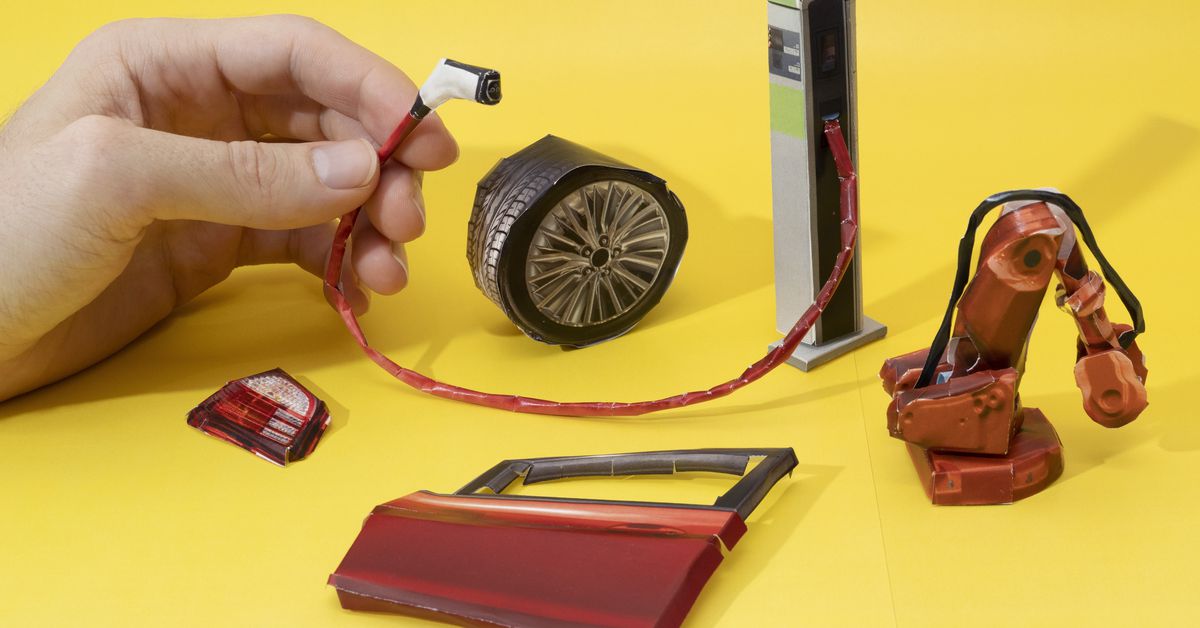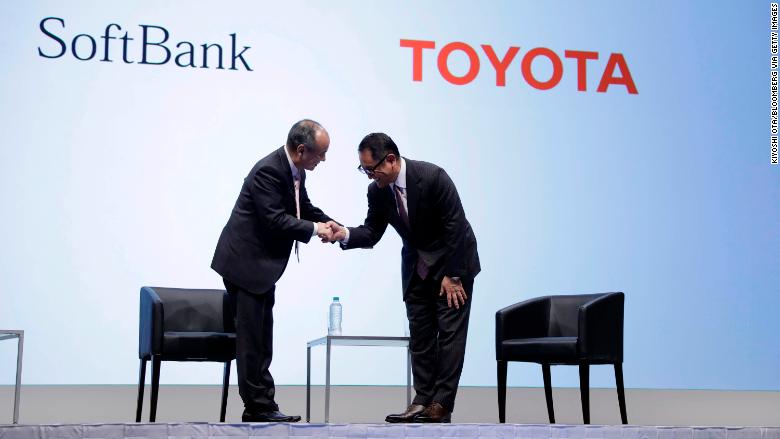Under the hood of the electric vehicle revolution
Illustration by Ben Denzer for Vox; Photographs by Emily Elconin for VoxIn the EV era, old automakers are learning new tricks. Part of Back to the Future, from The Highlight, Vox’s home for ambitious stories that explain our world....

/cdn.vox-cdn.com/uploads/chorus_image/image/71506131/Vox_EV_A1.0.jpg) Illustration by Ben Denzer for Vox; Photographs by Emily Elconin for Vox
Illustration by Ben Denzer for Vox; Photographs by Emily Elconin for Vox
In the EV era, old automakers are learning new tricks.
:no_upscale()/cdn.vox-cdn.com/uploads/chorus_asset/file/21899595/VOX_The_Highlight_Box_Logo_Horizontal.png)
Part of Back to the Future, from The Highlight, Vox’s home for ambitious stories that explain our world.
LAKE ORION, Michigan — The battery packs arrive at the General Motors plant in Lake Orion, a tiny village 30 miles north of Detroit, in large capsules. Amid the clanks and clunks of the assembly floor, workers pry the capsules open before robotic buggies shuttle them away, guided by magnetic tape that trails along the ground. Eventually, they arrive underneath what amounts to an overhead conveyor belt, a miles-long industrial track that carries scores of half-built Chevrolet Bolt EVs across the factory. Then, stretching upward like an accordion, machinery lifts the batteries up into the bottom of the vehicles’ frames, where, finally, a worker can bolt them together.
This is what the great electric vehicle transition looks like on the assembly line. A few years ago, things would have worked very differently at the Orion Assembly plant, which first opened back in 1983. The conveyor system would have carried different models, like the Chevy Sonic and Buick Verano — internal combustion vehicles that GM has since discontinued. There would have been a fluid fill station, where workers used to put a small amount of fuel into new cars’ tanks. Today, the gas pump is gone, and there’s an adjusted line for installing electric propulsion parts, rather than gas-powered engines.
GM was the first of the Big Three automakers to commit to going fully electric, and the company is now racing to meet surging demand for new EVs. Orion Assembly is the first internal combustion facility that GM repurposed to exclusively assemble green cars. The plant currently makes the Chevy Bolt EV, a hatchback that will start at $26,595 for the 2023 model, and the slightly larger, slightly more expensive Chevy Bolt EUV.
:no_upscale()/cdn.vox-cdn.com/uploads/chorus_asset/file/24088824/Elconin_Vox_12.jpg) Chevy Bolt EVs in beginning production stages are seen at Orion Assembly, a General Motors vehicle assembly plant in Lake Orion, Michigan, on September 14.
Chevy Bolt EVs in beginning production stages are seen at Orion Assembly, a General Motors vehicle assembly plant in Lake Orion, Michigan, on September 14.
“Changing over to an EV from an internal combustion engine vehicle, you’re really just changing the propulsion system,” said Ken Morris, GM’s vice president of electric, autonomous, and fuel cell programs. “It’s the same type of historical parts that we’ve always used. The seats are the seats and the tires are the tires. The body structure is integrated differently because we’re attaching a battery pack.”
Replacing gas engines with 1,000-pound batteries is a pretty significant update. Still, longtime automakers seem to be in search of an EV revolution that requires as little change as possible, at least from a manufacturing perspective. They want to use the factories they already have and stick with the models that their customers are already familiar with. (For example, to much fanfare, Ford started shipping an electric version of its popular F-150 pickup earlier this year.)
But the future of American auto manufacturing won’t look anything like its past. This switch will be a major transformation for the auto industry, creating new winners and losers, political tensions, and a range of open questions. Unions and the state of Michigan, for instance, were the centerpiece of America’s internal combustion age, but that’s already far from the case in the still-nascent EV era.
Motor City, meet Silicon Valley
EVs have given the Orion plant a second life. Built during a slump in Michigan’s auto industry, Orion Assembly was supposed to signal that things were finally turning around. With machinery that included nearly 140 high-tech robots, GM hoped the plant would mark a new era in manufacturing automation. When President Ronald Reagan spoke at the plant’s dedication ceremony in 1984, he declared the site an “admirable commitment to the future of America.” Orion Assembly started out producing Cadillac models, but over the course of several decades, it made everything from the Oldsmobile Aurora to the Pontiac Bonneville.
Then, in early 2014, a group of workers at the plant was brought on to work on a secret project. Marland “Lanny” Brown, a Michigan native who’s spent decades working at the Orion facility, was part of that team, and he eventually flew to South Korea to learn about a new electric vehicle concept GM had been developing in collaboration with electronics manufacturer LG.
:no_upscale()/cdn.vox-cdn.com/uploads/chorus_asset/file/24088683/Elconin_Vox_59.jpg) Marland “Lanny” Brown has worked at Orion Assembly for decades and was one of the first to begin working on the transition to electric vehicles at the plant.
Marland “Lanny” Brown has worked at Orion Assembly for decades and was one of the first to begin working on the transition to electric vehicles at the plant.
“There are more electrical components in this car. This car is run more by modules and controls,” Brown explained on a recent visit to the Orion plant. “Because of the voltage and everything that’s involved, it was a whole different concept.”
After GM announced that it would start production on its Chevy Bolt EV in 2015, the company spent $160 million on new equipment, tooling, and build cells for Orion Assembly. To make the transition, GM repurposed space on the floor once used for gas tank installation and started training workers on how to handle new electrical components.
Still, Brown said, much of the facility’s approach has remained the same. Like earlier internal combustion vehicles, the Chevy Bolt frame is welded together by robots, and another team of robots paints the vehicle. Once equipment like weather stripping and seats are added, the half-built car is carried by the conveyance system to a special area, where the battery is finally installed.
While the assembly of the body of EVs is relatively similar to that of gas-powered cars, building internal combustion engines is nothing like building EV powertrains. Fossil fuel engines require a complex array of machinery, such as metal castings and several gears, while EVs generally don’t need geared transmissions or engines. Manufacturing the batteries that power these motors often takes place at a different facility, and involves turning refined materials like lithium, graphite, and cobalt into battery cells. These cells package together components like anodes, cathodes, and electrolytes into flat pouches, thousands of which are then packed into bigger modules, and then into the final half-ton battery pack.
:no_upscale()/cdn.vox-cdn.com/uploads/chorus_asset/file/24089444/Elconin_Vox_7.jpg) Dozens of Chevy Bolt EV vehicles move through the assembly line at Orion Assembly.
Dozens of Chevy Bolt EV vehicles move through the assembly line at Orion Assembly.
EV batteries can be dangerous, too. The liquid electrolyte in the lithium-ion batteries typically used for electric vehicles is extremely flammable. When a battery is damaged or has a defect, this electrolyte can ignite, heating the battery uncontrollably. So while EV fires occur far less often than internal combustion vehicle fires, they tend to be more severe and last longer.
Defects in the Chevy Bolt battery made the car particularly prone to this problem. After a series of Chevy Bolts spontaneously burst into flames, the National Highway Traffic Safety Administration started issuing recalls, and even told Chevy Bolt owners not to park near other cars. By 2021, GM had recalled every Bolt ever produced. Retooling the battery forced Orion Assembly to shut down, and it only resumed production this past April.
Nevertheless, GM is moving forward with its EV ambitions. As part of a $4 billion expansion announced in January, Orion will soon add two new trucks to its roster: electric versions of the GMC Sierra and the Chevy Silverado. To boost its production capacity, new paint and body shops and a new battery facility will be built along the sides of the current plant — a massive construction project.
In September, GM said that it would spend $760 million to upgrade an internal combustion propulsion plant in Toledo, Ohio, to build drive units for electric trucks, and another $491 million to retrofit a facility in Indiana to make steel and aluminum parts for future cars, including EVs. GM also recently renovated a factory in Spring Hill, Tennessee, to build electric Cadillacs.
GM’s competitors are taking a similar tack. Stellantis, the company that owns brands like Jeep and Chrysler, is spending billions to retrofit factories everywhere from Canada to Serbia for EV manufacturing. Some startups have taken the same approach: This year, Rivian opened an EV factory at a former Mitsubishi plant in Illinois that shut down in 2016. This is all in an effort to catch up with Tesla, which produced nearly 70 percent of the new EVs registered in the US last year and is usually the world’s largest electric vehicle manufacturer, depending on the quarter.
The emerging EV workforce
From Tesla’s perspective, the future of American-made cars isn’t in Detroit, and it doesn’t involve unions. The company was founded in San Carlos, California, and is headquartered in Austin, Texas, many states away from Michigan. Tesla CEO Elon Musk has made no secret that he’s opposed to labor organizing. He’s even dared the United Auto Workers (UAW), the national union that represents most car workers, to hold a unionization vote at one of his factories.
There’s a different attitude at Orion Assembly, where more than 1,000 workers are members of Local 5960, the plant’s chapter of the UAW, and union swag is a fixture on the factory floor. For the Orion union branch, the EV transition has meant the promise of more jobs and an expansion that will approximately triple the number of people working at the facility.
:no_upscale()/cdn.vox-cdn.com/uploads/chorus_asset/file/24088661/Elconin_Vox_39.jpg) Assembly workers tend to Chevy Bolt EV vehicles on an assembly line.
Assembly workers tend to Chevy Bolt EV vehicles on an assembly line.
But UAW leadership is cautious about the big pivot to electric vehicles. Automakers have made no secret of the fact that the EV age may require a smaller labor force. Electric vehicles have fewer overall parts than internal combustion vehicles and may need less work to put together. Ford said in August that it would cut 3,000 positions amid the transition, and the CEO of Volkswagen has said that the shift could eventually mean losing as many as 30,000 jobs at his company. There’s also concern that automakers could use the switch to EVs to open more plants outside of Michigan, including in Southern states that aren’t as union-friendly.
“A lot of the work that has been done in the past has been done with, essentially, contract workers there,” said Keith Cooley, who worked at GM for 25 years and is now president and CEO of Principia, which focuses on the clean economy. “Many of those contract workers are people of color and do not have the same rate of migration into working for the company itself or working for the union.”
The Department of Labor told Recode that, over the next decade, jobs in vehicle manufacturing are expected grow somewhat faster than the overall economy, while jobs in auto parts manufacturing will grow at a much slower rate. Still, auto workers involved in an MIT-funded study said that they’re worried about a wide range of issues with the EV transition, including fears that EVs won’t be a hit with consumers and concerns that companies will shut down the internal combustion facilities where they work and leave them behind. Many of the workers don’t have the confidence in EVs that managers and executives do, according to Sanya Carley, an Indiana University professor who worked on the MIT project.
“We believe the transition to electric vehicles will happen, but it must not happen at the expense of current members making [internal combustion engine] vehicles,” UAW president Ray Curry said in a statement. “The transition to EVs will not happen overnight. We are at a moment where we can change the supply chain model for the next generation of vehicles to have more parts built here with good union wages.”
New and retrofitted EV plants can also create severe environmental hazards and pollution — including emissions and noxious odors — especially for communities who live nearby. One of the clearest examples is the Stellantis Mack Assembly plant, which is located in a majority-Black neighborhood on Detroit’s east side. The Environmental Protection Agency (EPA) is investigating whether the Michigan Department of Environment, Great Lakes, and Energy racially discriminated when it decided where to approve the new plant. This is after that state agency flagged the Stellantis plant for several air quality violations.
:no_upscale()/cdn.vox-cdn.com/uploads/chorus_asset/file/24089359/GettyImages_1239417946a.jpg) The Stellantis Mack Assembly Plant is seen here in February directly behind a church and homes along East Canfield Street in Detroit, Michigan.Matthew Hatcher/Bloomberg via Getty Images
The Stellantis Mack Assembly Plant is seen here in February directly behind a church and homes along East Canfield Street in Detroit, Michigan.Matthew Hatcher/Bloomberg via Getty Images
Auto workers are also worried that car companies will prioritize their growing number of software engineers over the people who work at assembly and other manufacturing plants. As cars have gone electric and gained increasingly autonomous features, they’ve also turned into sophisticated electronic devices powered by millions of lines of code. As a result, there’s fear that carmaking could eventually look a lot less like the production line at Orion and a lot more like desk work, and even remote desk work. GM currently has at least 10,000 people working on software and more than 500 people focused on cybersecurity.
“This process is happening across the board, but that demand for continuous software talent is going to grow. Because now, not only the technology companies are going after them, the automotive companies are also going after them,” said Padma Sundaram, the director of software-defined vehicles at GM.
The new politics of EVs
This is only the beginning of the EV transition. Plants like Orion Assembly are already struggling to produce enough cars and trucks to meet consumer demand, and new incentive programs from state and federal governments promise to encourage even more Americans to ditch their fossil fuel vehicles. That’s why President Joe Biden and a gaggle of other high-profile Democrats, including Secretary of Transportation Pete Buttigieg and Michigan Gov. Gretchen Whitmer, made appearances at the North American International Auto Show in Detroit last month.
For the White House, the choice to attend was simple political math. It was the first in-person Detroit auto show since 2019, and the car industry, union leadership, and throngs of startups were gathering to celebrate one of America’s biggest industries just a few weeks before midterms in a swing state. And in the halls of Huntington Place in downtown Detroit, which was filled with new electric cars and trucks as well as futuristic charging tech, Biden’s vision for the American EV industry seemed all but inevitable.
:no_upscale()/cdn.vox-cdn.com/uploads/chorus_asset/file/24089399/GettyImages_1243235417a.jpg) President Joe Biden speaks at the 2022 North American International Auto Show in Detroit, Michigan, on September 14.Erin Kirkland/Bloomberg via Getty Images
President Joe Biden speaks at the 2022 North American International Auto Show in Detroit, Michigan, on September 14.Erin Kirkland/Bloomberg via Getty Images
“As I met with the CEOs of the different traditional automakers in Detroit, one of the things they made very clear to me is that they are all-in, to the extent that they’re taking actually big risks as businesses: depending on the national environment to continue favoring electric,” Buttigieg told Recode in a recent interview, “because they’ve passed some points of no return.”
But the new politics of electric vehicles are tricky on both the state and national level. Michigan politicians on both sides of the aisle see the rise of EV manufacturing as a potential renaissance for the state’s auto industry, as well as for the communities and workers that depend on it. State politicians have pushed for the opening of new plants, and local governments have wooed companies with enticing tax advantages. In Lake Orion, for example, the local township has awarded GM a 12-year, $1.3 billion tax abatement to expand its facilities there. Gov. Whitmer has pushed for incentives for more companies to build EV factories, though she’s also faced criticism from Michigan Republicans who argue that her efforts haven’t stopped automakers from building new EV factories in other states.
Indeed, the auto industry has been expanding from Michigan to other parts of the country for years. And Biden’s big campaign to boost American-made EVs doesn’t necessarily mean those vehicles will be made in Michigan.
“Michigan’s auto workers are the best in the business, but different states and different countries are going to be competing for these kinds of major investments,” Rep. Elissa Slotkin (D-MI), whose district includes Lake Orion, told Recode. “The US is going to have to compete with China and other countries with much looser wage and labor laws.”
Just like Michigan, New York, Georgia, Kentucky, and North Carolina have all offered tax breaks and grants to companies that build new EV, battery, and component factories in their respective states. Internationally, the US has dominated, and remains a major player, in the internal combustion market. But many countries, including Germany and Japan, are vying for that status in the EV era, which is still taking shape. For now, China currently produces many of the world’s electric vehicles, and last year, China was responsible for more than 70 percent of the world’s EV battery manufacturing, according to the International Energy Agency.
EVs and the beginning of the future
Back at Orion Assembly, there are already hints that yet another massive transformation for the auto industry is on the horizon. Most of the half-complete car frames, battery packs, and chassis traveling about the factory are destined to become Chevy Bolt EVs and EUVs — and they’ll play a key part in GM’s plan to produce 1 million zero-emission vehicles per year by 2025. But a small, select few are pulled aside for a rest stop, of sorts. At a station on the assembly floor, workers line the inside of the car frames with an intricate array of electronics, logging each addition on a special computer nearby. Cameras and sensors are eventually installed on the roof, transforming an EV into a self-driving car.
:no_upscale()/cdn.vox-cdn.com/uploads/chorus_asset/file/24089496/GettyImages_1238159533.jpg) A Cruise vehicle in San Francisco, California, in February. David Paul Morris/Bloomberg via Getty Images
A Cruise vehicle in San Francisco, California, in February. David Paul Morris/Bloomberg via Getty Images
This is the Cruise AV, the primary vehicle used by Cruise, GM’s autonomous vehicle subsidiary. A small fleet of these cars is currently traversing the streets of San Francisco, and they’ll begin tests in Austin and Phoenix in the coming months.
To be clear, self-driving vehicles are still being developed — depending on who you ask, they could arrive somewhere between the next few years and the next few decades. In the meantime, the upcoming surge in EV manufacturing is still a big bet, and it’s predicated on the idea that people will buy them, and buy them in droves. But while EV sales have accelerated, they’re around just 5 percent of the new cars people are buying in the US right now, and many consumers remain cautious. For automakers, this reality means marketing an EV future to workers and customers while continuing to operate and profit in the still mostly gas-powered present.
“They can convert their factories over,” explains Brett Smith, the technology director at the Center for Automotive Research. “But what makes it really challenging is that they have to do it while still trying to figure out how to build internal combustion engine cars.”
:no_upscale()/cdn.vox-cdn.com/uploads/chorus_asset/file/24088920/Elconin_Vox_22.jpg) A Chevy Bolt makes its way down the assembly line at Orion Assembly.
A Chevy Bolt makes its way down the assembly line at Orion Assembly.
How many people will buy EVs remains unclear and, to some extent, hinges on how much automakers can make the new seem as convenient, affordable, and exciting as the old.
That could be tough. Lanny Brown, the longtime Orion employee who worked on the Chevy Bolt core team, has only positive things to say about driving EVs, and he says they’re perfect for commuters. Brown personally has no plans to get one, though, since he’s nearing retirement.
“I live quite a ways from here,” he said. “And I’m lining up to buy my last truck.”

 ValVades
ValVades 
































